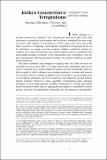India's Counterforce Temptations: Strategic Dilemmas, Doctrine, and Capabilities
Author(s)
Clary, Christopher; Narang, Vipin
DownloadPublished version (180.0Kb)
Publisher Policy
Publisher Policy
Article is made available in accordance with the publisher's policy and may be subject to US copyright law. Please refer to the publisher's site for terms of use.
Terms of use
Metadata
Show full item recordAbstract
Is India shifting to a nuclear counterforce strategy? Continued aggression by Pakistan against India, enabled by Islamabad's nuclear strategy and India's inability to counter it, has prompted the leadership in Delhi to explore more flexible preemptive counterforce options in an attempt to reestablish deterrence. Increasingly, Indian officials are advancing the logic of counterforce targeting, and they have begun to lay out exceptions to India's long-standing no-first-use policy to potentially allow for the preemptive use of nuclear weapons. Simultaneously, India has been acquiring the components that its military would need to launch counterforce strikes. These include a growing number of accurate and responsive nuclear delivery systems, an array of surveillance platforms, and sophisticated missile defenses. Executing a counterforce strike against Pakistan, however, would be exceptionally difficult. Moreover, Pakistan's response to the mere fear that India might be pursuing a counterforce option could generate a dangerous regional arms race and crisis instability. A cycle of escalation would have significant implications not only for South Asia, but also for the broader nuclear landscape if other regional powers were similarly seduced by the temptations of nuclear counterforce.
Date issued
2019-02Department
Massachusetts Institute of Technology. Department of Political ScienceJournal
International Security
Publisher
MIT Press
Citation
Clary, Christopher and Vipin Narang. "India's Counterforce Temptations: Strategic Dilemmas, Doctrine, and Capabilities." International Security 43, 3 (February 2019): 7-52 © 2019 the President and Fellows of Harvard College and the Massachusetts Institute of Technology
Version: Final published version
ISSN
0162-2889
1531-4804